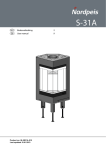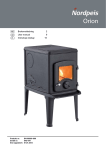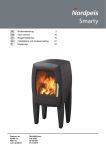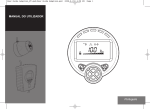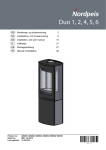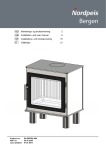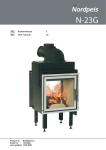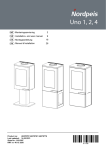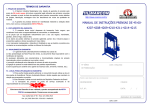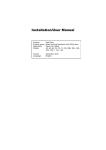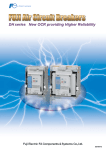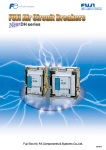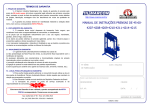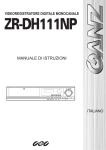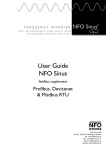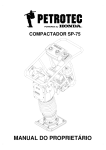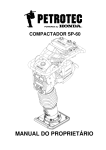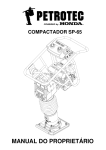Download NO Brukerveiledning 2 GB User manual 10 DK
Transcript
NI-22 NOBrukerveiledning GB User manual DKBrugervejledning SE Installations- och bruksanvisning 22 FI Käyttöohje Product no: IN-00N22-xxx Sintef no: 041-169 RRF no: 29 09 1917 Last updated: 01.01.2013 2 10 16 28 1. Prior to assembling the insert INDEX 1. Prior to assembling the insert Chimney draught 10 10 2. Technical information 11 3. Distance to combustible material 11 4. Assembly Connection of the flue Operating control Painting the surround 11 12 12 12 5. Lighting the fire for the first time 12 6. Maintenance 13 Cleaning and inspection 13 Ashes13 Thermotte™13 Door and glass 13 7. Warranty 13 8. Advice on lighting a fire 14 Some advice in case of combustion problems 15 All our products are tested according to the latest European requirements and also to the Norwegian standard NS 3058 and NS 3059, which include particle tests. However, several European countries have local regulations for installation of fireplaces, which change regularly. It is the responsibility of the client that these regulations are complied with in the country/region where the fireplace is installed. Nordpeis AS is not responsible for incorrect installation. Important to check (please note that this list is not exhaustive): • distance from firebox to combustible/flammable materials • insulation materials/requirements between fireplace surround and back wall • size of floor plates in front of fireplace if required • flue connection between firebox and chimney • insulation requirements if flue passes through a flammable wall Chimney draught Compared with older models, the clean burning inserts of today put significantly higher demands on the chimney. Even the best insert will not work properly if the chimney does not have the right dimensions or is not in good working order. The draught is mainly controlled by gas temperature, outside temperature, air supply as well as the height and inner diameter of the chimney. The diameter of the chimney should never be less than that of the flue/ chimney collar. At nominal effect there should be a negative pressure of 12 to 25 Pascal. The draught increases when: • The chimney becomes warmer than the outside air • The active length of the chimney over the hearth increases • Good air supply to the combustion It can be difficult to obtain the right draught conditions in case the chimney is too large relative to the insert, as the chimney does not heat up well enough. In such cases you may want to contact professional for evaluation of possible measures. Draught that is too strong can be controlled with a damper. If necessary, contact a chimney sweeper. For your own safety, comply with the assembly instructions. All safety distances are minimum distances. Installation of the insert must comply with the current rules and regulations of the country where the product is installed. Nordpeis AS is not responsible for wrongly assembled inserts. Subject to errors and changes. For the latest updated version go to www.nordpeis.com. 10 GB 2. Technical information 3. Distance to combustible material The inserts from Nordpeis all have secondary combustion and are clean burning. The combustion takes place in two phases: first the wood burns and then the gases from the fumes are lit by the hot air. This ensures that these new inserts have minimal emissions of soot particles and un-burnt gases (such as CO) and are thus better for the environment. Clean burning inserts require a small amount of wood in order to obtain a good heat output. Use exclusively clean and dry wood. We recommend seasoned hardwood with a maximum moisture content of 20%.. Firewall Ensure that the safety distances are respected (FIG 1). When connecting a steel chimney to the top outlet use the security distances required from the manufacturer. Important! When placing the insert on a combustible floor, a steel plate of at least 0.7mm must cover the entire floor surface inside the surround. Any flooring made of combustible material, such as linoleum, carpets etc. must be removed from underneath the steel plate. Insert NI-22 Material Cast iron Surface treatment door / doorframe Heat resistant varnish 4. Assembly Fuel: Wood logs, 35 cm Operating range 6 kW Efficiency 78,2 CO % @ 13% O2 0,08 Draught system Ignition vent control and air vent control The following tools are necessary: • 10 mm and 13 mm spanner/wrench • Electrical drill / Phillips screwdriver (for self tapping screws) • Caulking gun (for the stove cement) Combustion system Secondary combustion (clean burning) Heating area 30-150 m² Flue outlet Top, posterior and lateral Flue Inner Ø 150 mm *Alternative versions exsists due to National requirements Weight of insert 108 kg Area of convection air vent under insert 400 cm² Area of convection air vent over insert 600 cm² Minimum distance from convection air outlet to ceiling 1. Ensure that all the loose parts are included (FIG 2): A. Heat shield in two parts with 4 self drilling screws B. Lid for flue outlet with fastening bracket, screw and nut C. Smoke dome D. 2 fasteners with bolts and disks for the smoke dome E. Insert with door F. 3 fastening bolts with disks for the legs G.3 legs with adjusting bolts and lock nuts H. Glove The insert expands when in use, and for this reason the insert must NEVER rest on the surround, but have a gap of about 3 mm. The insert must neither rest on the bench plate or against the sides. It is recommended to dry stack the surround in order to adjust the insert prior to perforating the chimney for the flue connection. 500mm Flue gas temperature 310 °C Air supply requirements (m³/h) 18 Fuel charge 1,8kg Refueling interval 55 min Opening of the air vent control 100% Operation Intermittent* * Intermittent combustion refers to normal use of a fireplace, i.e. new wood is inserted when the previous load has burned down to ember Warning: If the requirements for ventilation are NOT complied with, the heating circulation effect will be considerably reduced and overheating can occur. This can in a worst case scenario cause a fire. 2. Carefully lay the insert on its back. Ensure that the transportation padding is put inside the insert before turning it over, so that the insulating plates in the burn chamber do not fall down and break. Please note that the insulating plates may release coloured dust when touched. Avoid touching the cast iron with dust on your fingers. In case of dust on any cast iron part, the glove included is well suited to brush it off. Start with assembling the legs (FIG 3) as follows: • Fasten the screws on to the insert with a 13 mm spanner/wrench. The legs are placed as shown (the opening in the legs should face outwards). GB 11 • Use the adjusting bolts (FIG 4) and adjust the legs to the desired height (X) before returning the insert to an upright position (do not tilt the insert). The height depends on the surround. Regulation of leg height (X) for NI-22: From: 240 mm To: 380 mm. 3. Install the smoke dome (FIG 5A). The dome is assembled with a fastener on each side. Use a 10 mm spanner/wrench and the fastening disks and bolts that are included with the insert. The lid for the smoke dome is normally already mounted on the top for a posterior connection. If the fireplace will be connected to a chimney at the top, move the smoke lid to the rear flue outlet (FIG 5B). Use the parts as shown in the illustration. 4. Install the heat shield around the smoke dome (FIG 6). The heat shield comes in two parts that are fastened with 4 self-drilling screws. Fasten the heat shield so that the flue can be connected later. Connection of the flue Please be aware when connecting the 150 mm flue to the smoke dome that the flue is placed outside the flue outlet collar. *Alternative versions exsists due to National requirements For the flue connection to the chimney, follow the recommendations from the chimney manufacturer. Air vent control (top right corner) Pushed in = closed Pulled out = open Left position = closed Right position = open Lighting a fire Insert small dry pieces of kindling wood, ignite and ensure that the flames have a good grip of the wood before closing the door. Open the ignition vent control (Fig A) as you close the door. When the flames are stable and the chimney is warm, close the ignition vent control. If it is not closed the insert and chimney may overheat. The air supply is then regulated with the air vent control. (Fig B). NB! If the draught is low after the fire has been lit, additional air supply can be added by opening the ignition vent control. FIG A Operating control When the insert is in an upright position, and prior to mounting the surround, check that all functions are easy to manoeuvre and appear satisfactory. Ignition vent control (bottom right corner) insulation plates which can result in a slower burn rate the first few times the insert is used. These will be resolved once the humidity has evaporated. Possibly leave the door slightly open the first 2-3 times that the insert is used. It is advisable to ventilate the room well when firing for the first time as the varnish on the product may release some smoke or smell. Both the smoke and smell will disappear and are not hazardous. Ignition vent control Air vent control When there is a glowing layer of ash, new wood logs can be inserted. Pull the hot ember to the front of the combustion chamber when inserting new logs so that the wood is ignited from the front. Keep the door slightly open each time new logs are inserted so that the flames get established. The fire should burn with bright and lively flames. Removing the self-closing mechanism FIG 9 (this applies only to the panoramic door) 1. Open the door. 2. Use a pair of pliers and grab the long piece on the spring. Gently pull the spring down and off. Painting the surround It is recommended to use the insert a few times in order to let the varnish harden before any eventual masking and painting. Only use water based emulsion paint and a designated masking tape. Carefully remove the tape in order not to damage the varnish. Using the insert with low combustion effect and firing around the clock increase pollution as well as the risk for a fire in the chimney. Never allow the insert or flue to become glowing red. Turn off the air vent control should this happen. Regulation of the air vent control takes some experience, but after a little while a natural rhythm for the fire will be found. IMPORTANT! Always remember to open the air vent control (preferably also the door) before new wood logs are inserted into a hot burn chamber. Let the flames get a good grip on the wood before the air control setting is reduced. When the draught in the chimney is low and the vent is closed, the gas from the firewood can be ignited with a bang. This can cause damages to the product as well as the immediate environment. 5. Lighting the fire for the first time When the insert is assembled and all instructions have been observed, a fire can be lit. Take care when inserting logs into the burn chamber, in order not to damage the Thermotte plates. Please note that there might be some humidity in the 12 FIG B GB 6. Maintenance when the glass is cold. Cleaning and inspection The insert should be inspected thoroughly and cleaned at least once per season (possibly in combination with the sweeping of the chimney and chimney pipes). Ensure that all joints are tight and that the gaskets are rightly positioned. Exchange any gaskets that are worn or deformed. Check regularly that the transition between the glass and the door is completely tight. Possibly tighten the screws that hold the glass in place - but not too hard, as this can cause the glass to crack. Periodically, it may be necessary to change the gaskets on the door to ensure that the burn chamber is air tight and working optimally. These gaskets can be bought as a set, usually including ceramic glue Remember that the insert must always be cold when inspected. Ashes The ashes should be removed at regular intervals. Be aware that the ashes can contain hot ember even several days after the fire is finished. Use a container of non-combustible material to remove the ashes. It is recommended to leave a layer of ashes in the bottom as this further insulates the burn chamber. Take care with the Thermotte plates when the ashes are removed, particularly when using an ash shovel, so as not to damage them. Thermotte™ These insulating plates in the burn chamber contribute to a high combustion temperature, which leads to cleaner combustion of the wood and a higher rate of efficiency. Any fissures in the plates will not reduce their insulation efficiency. If new plates are needed, contact your dealer. In case the plates need to be replaced, lift the smoke baffle (1) in order to remove the side plates. Should it be necessary to unhook the door/doors, unscrew the lid (FIG 8) above the air vent control. The lid is fastened underneath with 3 screws / Allen screws. When the lid is removed, the door/doors are free to unhook. CERAMIC GLASS CANNOT BE RECYCLED Ceramic glass should be disposed of as residual waste, together with pottery and porcelain * When exchanging the smoke baffle (part 1), the steel bracket must be removed and fastened on to the new one prior to assembly. Recycling of the ceramic glass Ceramic glass cannot be recycled. Old glass, breakage or otherwise unusable ceramic glass must be discarded as residual waste. Ceramic glass has a higher melting temperature, and can therefore not be recycled together with glass. If mixed with ordinary glass, it would damage the raw material and could, in worst case end the recycling of glass. It is an important contribution to the environment to ensure that ceramic glass does not end up with the recycling of ordinary glass. Please note: Wood logs that are too long can cause additional strain and crack the plates, due to the tension created between the side plates. Packaging Recycle The packaging accompanying the product should be recycled according to national regulations. 1. Smoke baffle* 2. Left side plate 3. Right side plate Please also note that the Thermotte plates may release coloured dust when touched. Avoid touching any cast iron parts with dust on your fingers. Any visible dust on cast iron can be brushed off with the glove that is included. Door and glass Should there be any soot on the glass it may be necessary to clean it. Use dedicated glass cleaner, as other detergents may damage the glass. (NB! Be careful, even dedicated glass cleaner can damage the varnish on the door frame). A good advice for cleaning the glass is to use a damp cloth or kitchen roll paper and apply some ash from the burn chamber. Rub around the ash on the glass and finish off with a piece of clean and damp kitchen roll paper. NB! Only clean 7. Warranty For detailed description of the warranty conditions see the enclosed warranty card or visit our website www.nordpeis.com The CE mark is placed on the side of the insert. 8. Advice on lighting a fire The best way to light a fire is with the use of lightening briquettes and dry kindling wood. Newspapers cause a lot of ash and the ink is damaging for the environment. Advertising flyers, magazines, milk GB 13 exceed the temperatures determined safe. Burning briquettes/ compact wood is done so at your own risk and only small amounts (max 1/3 of normal load) should be used for each load. cartons and similar are not suitable for lighting a fire. Good air supply is important at ignition. When the flue is hot the draught increases and door can be closed. Warning: NEVER use a lighting fuel such as petrol, karosine, alcohol or similar for lighting a fire. This could cause injury to you as well as damaging the product. Warning: NEVER use impregnated wood, painted wood, plywood, chipboard, rubbish, milk cartons, printed material or similar. If any of these items are used as fuel the warranty is invalid. Use clean and dry wood with a maximum moisture content of 20%. The wood should be dried for a minimum of 6 months after it is cut. Humid wood requires a lot of air for the combustion, as extra energy/heat is required for drying the humid wood and the heat effect is therefore minimal. This in addition creates soot in the chimney with the risk of creosote and chimney fire. Storing of wood In order to ensure that the wood is dry, the tree should be cut in winter and stored during the summer, covered and in a location with adequate ventilation. The wood pile must never be covered by a tarpaulin lying against the ground as the tarpaulin will then act as a sealed lid that will prevent the wood from drying. Always keep a small amount of wood indoors for a few days before use so that moisture in the surface of the wood can evaporate. Usage Not enough air to the combustion may cause the glass to soot. Hence, supply the fire with air just after the wood is added, so that the flames and gases in the combustion chamber are properly burnt. Open the air vent and have the door slightly ajar in order for the flames to establish properly on the wood. Common to these materials is that during combustion they can form hydrochloric acid and heavy metals that are harmful to the environment, yourself and the insert. Hydrochloric acid can also corrode the steel in the chimney or masonry in a masonry chimney. Also, avoid burning with bark, sawdust or other extremely fine wood, apart from when lighting a fire. This form of fuel can easily cause a flashover that can lead to temperatures that are too high. Warning: Make sure the insert is not overheated - it can cause irreparable damage to the product. Such damage is not covered by the warranty. Source “Håndbok, effektiv og miljøvennlig vedfyring” by Edvard Karlsvik SINTEF Energy Research AS and Heikki Oravainen, VTT. http//www.eufirewood.info Note that the air supply for the combustion also can be too large and cause an uncontrollable fire that very quickly heats up the whole combustion chamber to an extremely high temperature (when using with a closed or nearly closed door). For this reason you should never fill the combustion chamber completely with wood. It is recommended to keep an even fire with a small amount of wood. Too many logs put on hot ember, may result in combustion air starvation, and the gases will be released unburnt. For this reason it is important to increase the air supply just after adding logs. Choice of fuel All types of wood, such as birch, beech, oak, elm, ash and fruit trees, can be used as fuel in the insert. Wood species have different degrees of density - the more dense the wood is, the higher the energy value. Beech, oak and birch has the highest density. Attention! We do not recommend using fuel briquettes/ compact wood in our products. Use of such fuel may cause the product to overheat and 14 GB Some advice in case of combustion problems Error Explanation Solution The chimney is blocked. No draught The flue is sooty or there is accumulated soot on the smoke baffle. Contact a chimney sweeper / dealer for more information or clean the flue, smoke baffle and burn chamber. The smoke baffle is wrongly positioned. Verify the assembly of the smoke baffle - see assembly instructions. Downdraught in the room caused by no draught, that the house is too “air tight”. Light the fire with an open window. If this helps, more/bigger vents must be installed in the room. Downdraught in the room – caused by extractor and/or central ventilation system that pulls too much air out of the room. Turn off/regulate extractor and/or other ventilation. If this helps, more vents must be installed. The flues from two fireplaces/stoves are connected to the same chimney at the same height. One flue must be repositioned. The height difference of the two flue pipes must be of at least 30 cm. The flue is in a declining position from the smoke dome to the chimney. The flue must be moved so that there is an inclination of at least 10º from smoke dome to chimney. Possibly install a smoke suction device*. The flue is too far into the chimney. The flue must be reconnected so that it does not enter into the chimney but ends 5 mm before the chimney inner wall. Possibly install a smoke suction device*. Soot hatch in the basement or attic that is open and thus creating a false draught. Soot hatches must always be closed. Hatches that are not tight or are defected must be changed. Damper/top draught vents or doors on fireplaces that are not in use are open and create a false draught. Close damper, doors and top draught vents on fireplaces that are not in use. An open hole in the chimney after that a fireplace has been removed, thus creating a false draught. Holes must be completely sealed off with masonry. Defect masonry in the chimney, e.g. it is not airtight around the flue pipe entry and/or broken partition inside the chimney creating a false draught. Seal and plaster all cracks and sites that are not tight. The cross-section in the chimney is too large which results in no or very low draught. The chimney must be refitted, possibly install a smoke suction device*. The cross-section in the chimney is too small and the chimney cannot carry out all the smoke. Change to a smaller fireplace or build new chimney with a larger cross section. Possibly install a smoke suction device*. The chimney is too low and hence a poor draught. Increase the height of the chimney and/or install a chimney cap/ smoke suction device*. The chimney is too low in relationship to the surrounding terrain, buildings, trees etc. Increase the height of the chimney and/or install a chimney cap/ smoke suction device*. Turbulence around the chimney due to the roof being too flat. Increase the height of the chimney and/or install a chimney cap/ smoke suction device*. The fireplace combustion receives too much oxygen due to a leakage under the lower border of the insert or too strong chimney draught. Difficult to regulate the combustion and the wood burn up too quickly. Any possible leakage must be sealed off. A draught regulator or possibly a damper can reduce the chimney draught. NB! A leakage of only 5 cm2 is enough for 30% of the heated air to disappear. The smoke buffer is wrongly positioned. Verify the positioning of the smoke buffer – see assembly instructions. In case of using oven-dried wood, this requires less air supply than when using normal wood. Turn down the air supply. The gaskets around the door are worn and totally flat. Replace the gaskets, contact your dealer. The chimney is too large. Contact chimneysweeper or other professional for more details. The wood is too wet. Only use dry wood with a humidity of maximum 20%. The air vent control is closed too tightly. Open the air vent control to add air to the combustion. When new wood logs are inserted all vent controls should be completely opened or the door slightly opened until the flames have a good take on the wood. Bad combustion (the temperature is too low) Follow the guidelines in this user guide for correct combustion. White glass Using wrong material for combustion (such as: painted or impregnated wood, plastic laminate, plywood etc) Ensure to use only dry and clean wood. Smoke is released when the door is opened A levelling out of pressure occurs in the burn chamber. Open the air vent control for about 1 min before opening the door – avoid opening the door too quickly. The door is opened when there is a fire in the burn chamber. Open the door carefully and/or only when there is hot ember. The combustion temperature is too low. Increase the air supply. The wood is humid and contains water damp. Ensure to use only dry and clean wood. Insufficient combustion. Increase the air supply. The insert release smoke when lighting the fire and during combustion The fireplace releases smoke inside when it is windy outside. The fireplace does not heat sufficiently. Too much draught The glass is sooty White smoke Black or grey/ black smoke GB *Electric top chimney fan 15 NI-22 = mm 562 392 Ø 148 162 50 265 114 Ø 136 530 Ø148 34 > 240 < 380 298 88 625 440 516 295 Ø136 Extra radiation shield NI-22 NB! Bei der Montage in Deutschland, Österreich oder der Schweiz muss zusätzliches StrachlungsDet ekstra varmeskjoldet skal kun brukes når innsatsen har panoramadør blech verwendet werden. This radation shield is only to be used when the insert has a panoramic door NB! Écran de chaleur supplémentaire doit être utilisé pour assemblage en France. Ylimääräistä säteilysuojaa käytetään vain panoraamaluukkujen kanssa Skal endastdeve användas när innsatsen panoramadör NB! Scudo termico addizionale essere utilizzato perhar montaggio in Italia. Art.no: 22-01014-004 01.09.2009 35 FIG 1 =Brannmur/Brandmur/Turvaetäisyydet/Firewall =Brennbart materiale/Brændbart materiale/ Brännbart material/ Palavasta materiaalista/Combustible material >915 >800 >1140 >3 00 >20 >20 >20 >1000 >20 >600 36 FIG 2 X4 F F F G G G H 37 FIG 3 FIG 4 X 38 FIG 5A FIG 5B X2 UNLESS OTHERWISE SPECIFIED: DIMENSIONS ARE IN INCHES TOLERANCES: FRACTIONAL ANGULAR: MACH BEND TWO PLACE DECIMAL THREE PLACE DECIMAL INTERPRET GEOMETRIC TOLERANCING PER: PROPRIETARY AND CONFIDENTIAL THE INFORMATION CONTAINED IN THIS DRAWING IS THE SOLE PROPERTY OF <INSERT COMPANY NAME HERE>. ANY REPRODUCTION IN PART OR AS A WHOLE WITHOUT THE WRITTEN PERMISSION OF <INSERT COMPANY NAME HERE> IS PROHIBITED. 5 MATERIAL NAME APPLICATION TITLE: CHECKED MFG APPR. Q.A. COMMENTS: SIZE DWG. NO. REV NI-22 A assembly panorame . USED ON NEXT ASSY DATE DRAWN ENG APPR. FINISH 3 FIG 6 SHEET 1 OF 1 SCALE: 1:1 WEIGHT: DO NOT SCALE DRAWING 4 2 1 FIG 7 X4 FIG 8 39 FIG 9 Nordpeis AS, Gjellebekkstubben 11, N-3420 LIERSKOGEN, Norway www.nordpeis.no














